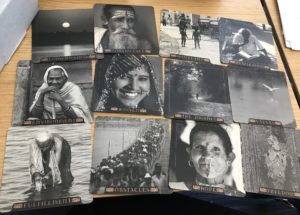Something I’ve been in deep rumination about this year is the amount of time I spend outside of the present in my daily life. A Pisces child, I’ve always been prone to dissociation from my reality into lands of my own creation. However, as college became a more tangible part of my life, I find myself so often preoccupied with anxiety-ridden thoughts of the future that I often fail to be properly present in spaces. This lack of consistent presence only hinders me from properly acknowledging and addressing issues that arise in my life in real time, and I am left often in rumination of particular life events weeks and sometimes even months later. This delay in my experiencing of self, has filled me with much consternation of recent especially as I get older and further develop and explore parts of myself.
This semester, however, I’ve begun to realize the acute importance and power in presence and have taken measures to intentionally include practices that allow me to feel completely within a space. What made the “Emergency Care of Wounds That Cannot Be Seen: Healing Justice & Ntozake Shange” event such a transformative and healing moment for me was how present everyone was, and was allowed to be. Although it was about reflecting, honoring, and thanking Ms. Shange for what she has contributed to our individual and collective lives, I find that it was as much about us as it was about her. The configuration of the room being a collection of chairs placed in a circle surrounding Shange’s altar, emphasized that it was just as much about seeing and appreciating her as much as it seeing each other, experiencing these moments as a collective. Within their expressions of gratitude to Shange, Cara Page, Ebony Noelle Golden, and Tiffany Lenoi Jones brought so much life into the space, while also challenging us to interrogate our positionalities and the ways in which it influences the amounts of space we feel entitled to take up. They stood to remind us that the words and impacts of Shange belong just as much to us as it does to them, and we shouldn’t fear the things that may arise in our spirits when in Western academic spaces. Although I find it a difficult and jarring feat to express myself and feelings whenever I feel them arise within the confines of this institution, I do value the reminder that I am allowed to take up as much space as possible.
A particular statement that I took away from this event that I feel is applicable not only to this course but the larger trajectory of my life’s work, was Ebony’s statement in regard to Shange, “I am a daughter of her imagination.” In a world where Black Women were habitually misunderstood, compartmentalized, oversimplified, and violated, Shange saw our inherent value and created worlds where we are central, multidimensional, human, and HEARD. It is in that acknowledgment and insistence on making sure through writing that we know that we are heard and not alone that her indelible impact lies.
Since coming to college, I’ve stopped writing poetry as much as I used to. What used to be an outlet for me to interrogate my feelings in real time, and allow myself moments of presence, had almost completely disappeared. However, last night I felt not only mobilized but that it was some sort of duty of mine to chronicle my thoughts and experiences in writing, if not for the healing of others, for the healing of myself. As Suzan Lori-Parks stated in her play, The Death of the Last Black Man in the Whole Entire World, “You should write it down because if you don’t write it down then they will come along and tell the future that we did not exist” (243). We exist, and we are inherently valuable and have a duty to remind and heal ourselves if not through writing through collective gathering, and it was this event that drove this point in for me.
Thank you Professor Hall and Professor Miller. Thank you Vani Natarajan. Thank you Cara Page, Ebony Noelle Golden, and Tiffany Lenoi Jones. Thank you members of the Shange Worlds Healing Committee. And most of all Thank you Ms. Shange for all of your efforts in making sure we are seen, heard, and can heal.





